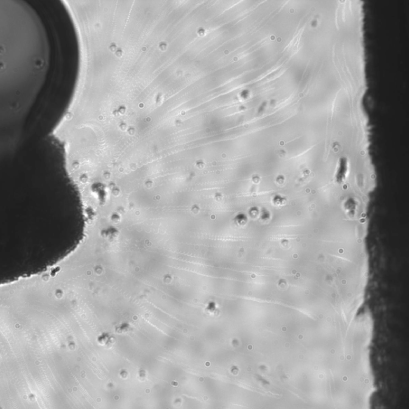Single-Molecule Biophysics
Dr. Kevin Freedman, Assistant Professor, Bioengineering,
University of California Riverside, Department of Bioengineering
Background
The Freedman Lab studies single molecule biophysics using a variety of electrical and optical signal measurements. Most notably, the lab studies complex biological systems where molecular populations are heterogeneous and difficult to study using ensemble averaging. Whenever working with single molecules, sensitivity is a big challenge. As a lab which focuses on single molecule detection, they require high end imaging equipment. This is not only for high sensitivity but also for high temporal resolution (i.e. fast frame rates). In some cases, fluorescent nanoscale beads are used to characterize the devices custom-fabricated in the lab so the need for fast sampling is a limiting factor.

Maximum intensity projection of electrically charged
beads moving through an electric field over time.
Electrically charged ports on the left and right hand side
of the image cause particles to move at high velocity
through the pore. The tracks that can be seen
show the movement of the beads.
Challenge
The Freedman Lab designs and characterizes nanofluidic devices that are used for biophysical or device physics (i.e. bead tracking) experiments. Often times, using the devices, nano-beads are transported at high velocities between two fabricated structures where speeds of up to 1000 fps are necessary to track them accurately.
To achieve this high frame rate, the exposure time needs to be 1 ms. This means the camera must be capable of reaching this high frame rate as well as being sensitive enough to detect the nano-beads with such a low exposure time. This isn't possible with the lower speed of an EMCCD camera, and front-illuminated sCMOS cameras lack the sensitivity.
We’ve been using the Prime 95B as one of our main cameras for both single molecule sensing and nano-bead velocity measurements. The Prime 95B Scientific CMOS is excellent for low-noise, high-sensitivity, and fast measurements.
Dr. Kevin Freedman
Solution
The Freedman Lab now uses the back-illuminated Prime 95B Scientific CMOS camera for their single molecule imaging experiments.
With 95% quantum efficiency, the Prime 95B has the sensitivity to detect particles with the 1 ms exposure time used in their challenging nano-bead velocimetry experiments. Also, with the increased speed afforded by CMOS technology, the Prime 95B can easily reach the desired 1000 fps frame rate. This allows accurate bead tracking in a range of experimental parameters which were not accessible before.
Dr. Freedman told us, "We've been using the Prime 95B as one of our main cameras for both single molecule sensing and nano-bead velocity measurements. The Prime 95B Scientific CMOS is excellent for low-noise, high-sensitivity, and fast measurements."

Learn More About the Prime 95B